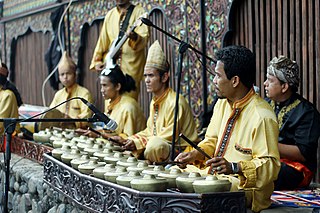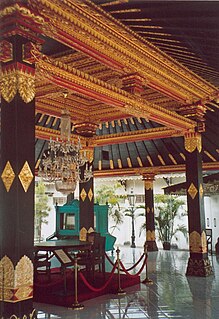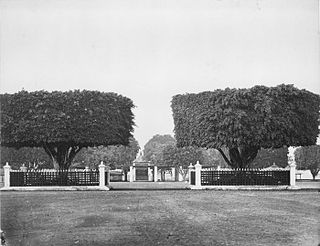
Gamelan is the traditional ensemble music of the Javanese, Sundanese, and Balinese peoples of Indonesia, made up predominantly of percussive instruments. The most common instruments used are metallophones played by mallets and a set of hand-played drums called kendhang/Kendang, which register the beat. The kemanak and gangsa are commonly used gamelan instruments in Bali. Other instruments include xylophones, bamboo flutes, a bowed instrument called a rebab, a zither-like instrument siter and vocalists named sindhen (Female) or gerong (Male).

The music of Indonesia its cultural diversity, the local musical creativity, as well as subsequent foreign musical influences that shaped contemporary music maybe scenes of Indonesia. Nearly thousands of Indonesian islands having its own cultural and artistic history and character. This results in hundreds of different forms of music, which often accompanies by dance and theatre.

Central Java is a province of Indonesia, located in the middle of the island of Java. Its administrative capital is Semarang. It is bordered by West Java in the west, the Indian Ocean and the Special Region of Yogyakarta in the south, East Java in the east, and the Java Sea in the north. It has a total area of 32,800.69 km2, with a population of 36,516,035 at the 2020 Census making it the third-most populous province in both Java and Indonesia after West Java and East Java. The province also includes the island of Nusakambangan in the south, and the Karimun Jawa Islands in the Java Sea. Central Java is also a cultural concept that includes the Special Region and city of Yogyakarta. However, administratively the city and its surrounding regencies have formed a separate special region since the country's independence, and is administrated separately. Although known as the "heart" of Javanese culture, there are several other non-Javanese ethnic groups, such as the Sundanese on the border with West Java. Chinese Indonesians, Arab Indonesians, and Indian Indonesians are also scattered throughout the province.

Gamelan surakarta A typical large, double gamelan in contemporary solo (Surakarta) will include, in the sléndro set, one saron panerus, two saron barung, one or two saron demung, one gendér panerus, one gender barung, one slenthem, one bonang panerus and one bonang barung, one gambang kayu, one siter or celempung, one rebab, one suling, one pair of kethuk and kempyang, one set of three to five kenong, one set of three to five kempul, one to three gong suwukan, and one gong ageng.

A gendèr is a type of metallophone used in Balinese and Javanese gamelan music. It consists of 10 to 14 tuned metal bars suspended over a tuned resonator of bamboo or metal, which are tapped with a mallet made of wooden disks (Bali) or a padded wooden disk (Java). Each key is a note of a different pitch, often extending a little more than two octaves. There are five notes per octave, so in the seven-note pélog scale, some pitches are left out according to the pathet. Most gamelans include three gendèr, one for sléndro, one for pelog pathet nem and lima, and one for pelog pathet barang.

Jody Diamond is an American composer, performer, writer, publisher, editor, and educator. She specializes in traditional and new music for Indonesian gamelan and is active internationally as a scholar, performer, and publisher.

The gong ageng is an Indonesian musical instrument used in the Javanese gamelan. It is the largest of the bronze gongs in the Javanese and Balinese gamelan orchestra and the only large gong that is called gong in Javanese. Unlike the more famous Chinese or Turkish tam-tams, Indonesian gongs have fixed, focused pitch, and are dissimilar to the familiar crash cymbal sound. It is circular, with a conical, tapering base of diameter smaller than gong face, with a protruding polished boss where it is struck by a padded mallet. Gongs with diameter as large as 135 centimeters have been created in the past, but gongs larger than about 80 centimeters are more common especially to suit the budget of educational institutions.

The bonang is an Indonesian musical instrument used in the Javanese gamelan. It is a collection of small gongs placed horizontally onto strings in a wooden frame (rancak), either one or two rows wide. All of the kettles have a central boss, but around it the lower-pitched ones have a flattened head, while the higher ones have an arched one. Each is tuned to a specific pitch in the appropriate scale; thus there are different bonang for pelog and slendro. They are typically hit with padded sticks (tabuh). This is similar to the other cradled gongs in the gamelan, the kethuk, kempyang, and kenong. Bonang may be made of forged bronze, welded and cold-hammered iron, or a combination of metals. In addition to the gong-shaped form of kettles, economical bonang made of hammered iron or brass plates with raised bosses are often found in village gamelan, in Suriname-style gamelan, and in some American gamelan. In central Javanese gamelan there are three types of bonang used:

Talempong is a traditional music of the Minangkabau people of Western Sumatra, Indonesia. The talempong produce a static texture consisting of interlocking rhythms.

The bedug is one of the drums used in the gamelan. It is also used among Muslims in Indonesia and Malaysia to signal mosque prayer times. The hitting of the instrument is particularly done according to a rhythm that goes in an increasingly rapid pace.
Notation plays a relatively minor role in the oral traditions of Indonesian gamelan but, in Java and Bali, several systems of gamelan notation were devised beginning at the end of the 19th century, initially for archival purposes.

Gamelan, although Indonesia is its origin place, is found outside of that country. There are forms of gamelan that have developed outside Indonesia, such as American gamelan and Malay Gamelan in Malaysia.
(Joseph) Vincent McDermott was a classically trained American composer and ethnomusicologist. His works show particular influence from the musics of South and Southeast Asia, particularly the gamelan music of Java. He was among the second generation of American composers to create and promote new compositions for gamelan.

Sekaten is a week-long Javanese traditional ceremony, festival, fair and pasar malam commemorating Maulid, celebrated annually started on 5th day through the 12th day of Mulud month.

Javanese culture is the culture of the Javanese people. Javanese culture is centered in the provinces of Central Java, Yogyakarta and East Java in Indonesia. Due to various migrations, it can also be found in other parts of the world, such as Suriname, the broader Indonesian archipelago region, Cape Malay, Malaysia, Singapore, Netherlands and other countries. The migrants bring with them various aspects of Javanese cultures such as Gamelan music, traditional dances and art of Wayang kulit shadow play.

Gamelan Munggang are considered among the most ancient gamelans of the kraton (courts) of central Java. The ensemble of instruments consists of gong ageng, kempul, kendang and horizontal gong chimes tuned to three pitches. Very low in absolute pitch, each ensemble consists of two types: pelog and slendro. There is a repertory of several repetitive pieces, the best known permutation being high-middle-high-low. It is theorized that pelog was derived from the three note munggang scale. The origin of the munggang ensembles themselves are described in Javanese myths, however the first one may have been imported to Indonesia in the first century CE, with the first ensemble constructed by the Javanese made in the 4th century.

Javanese dance is the dances and art forms that were created and influenced by Javanese culture in Indonesia. Javanese dance movement is controlled, deliberate and refined. Javanese art often displays a finesse, and at the same time a serene composure which is elevated far above everything mundane. Javanese dance is usually associated with courtly, refined and sophisticated culture of the Javanese kratons, such as the bedhaya and srimpi dance. However, in a wider sense, Javanese dance also includes the dances of Javanese commoners and villagers such as ronggeng, tayub, reog, and jaran kepang.

An alun-alun is a large, central, open lawn square common to villages, towns and cities in Indonesia.

The Srimpi is a ritualized dance of Java, Indonesia, associated with the royal palaces of Yogyakarta and Surakarta. The srimpi dance is one of the classical dance of Central Java. Along with the bedhaya, srimpi epitomized the elegance character of the royal Javanese court, and the dance became a symbol of the ruler's power as well as the refinement of Javanese culture.

Kauman Great Mosque, approximate English translation of Javanese Mesjid Gedhe Kauman is a Great Mosque of the Yogyakarta Sultanate in Java, Indonesia. It is located to the west of the North Alun-alun of Yogyakarta Kraton.




















